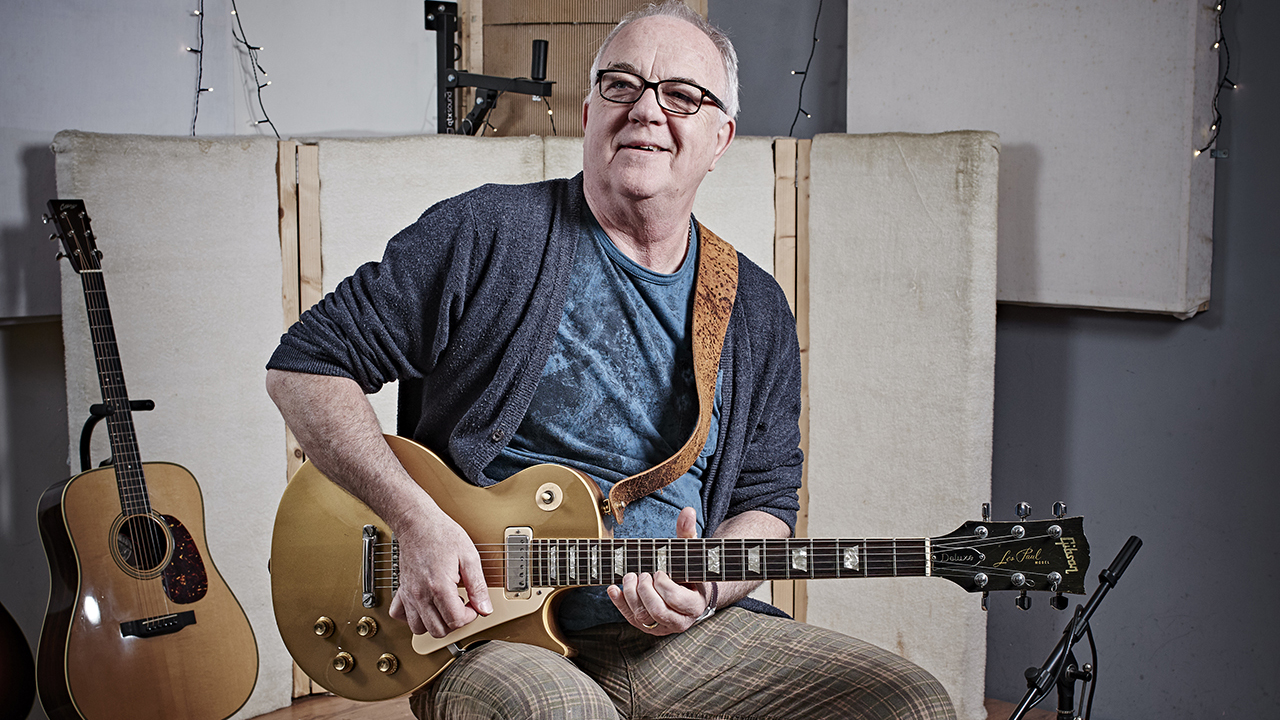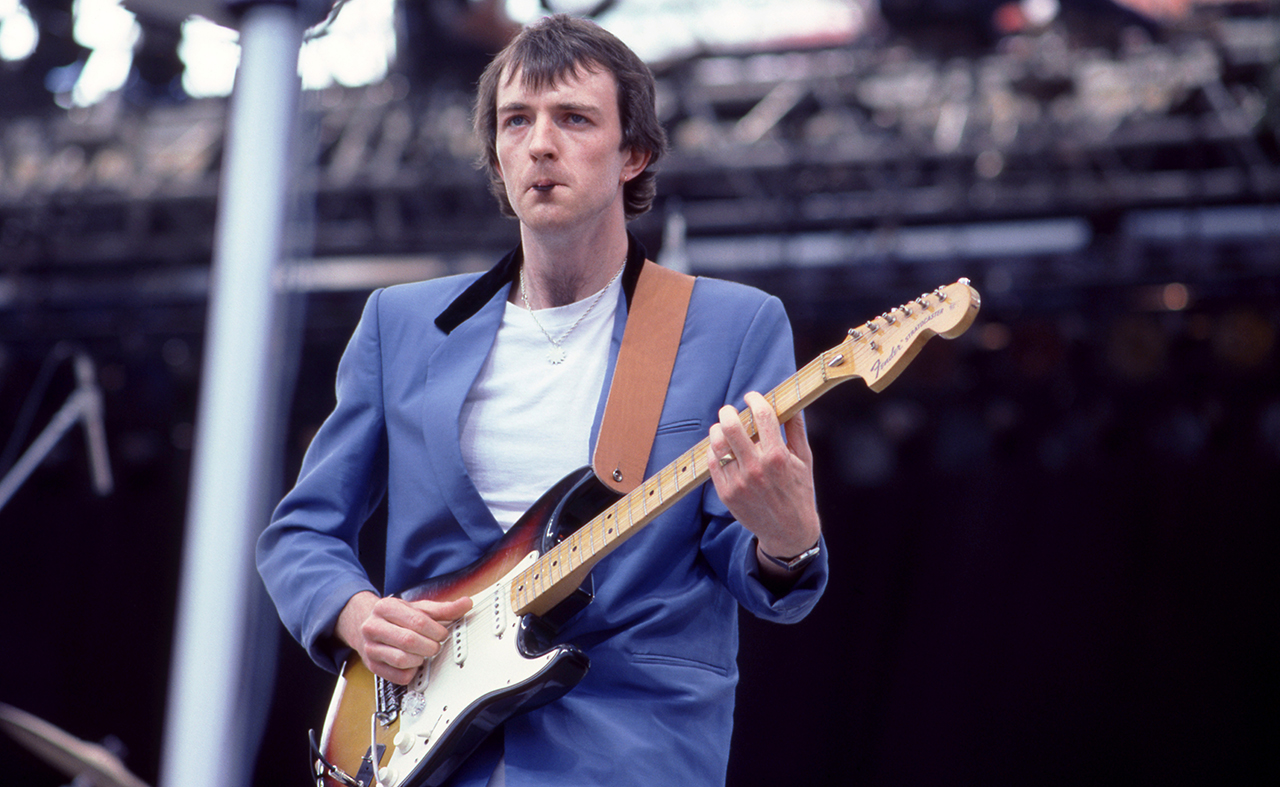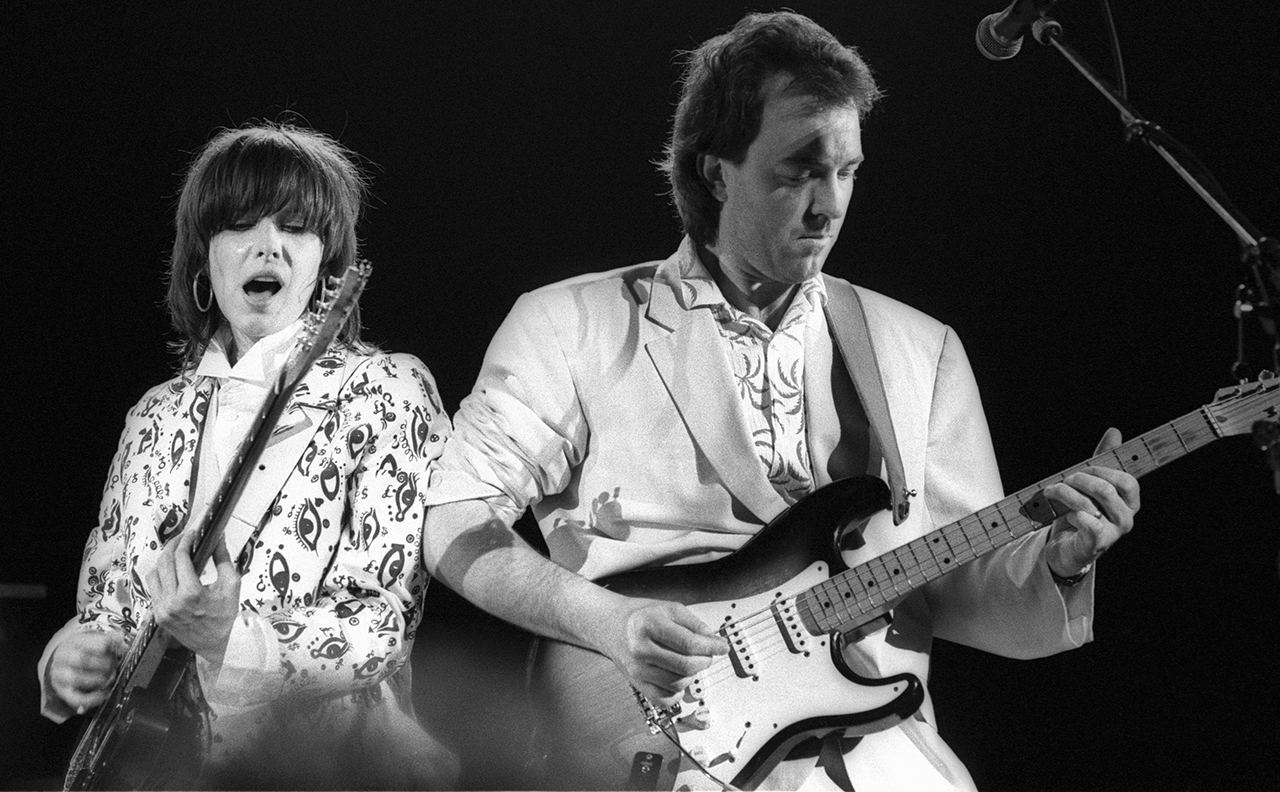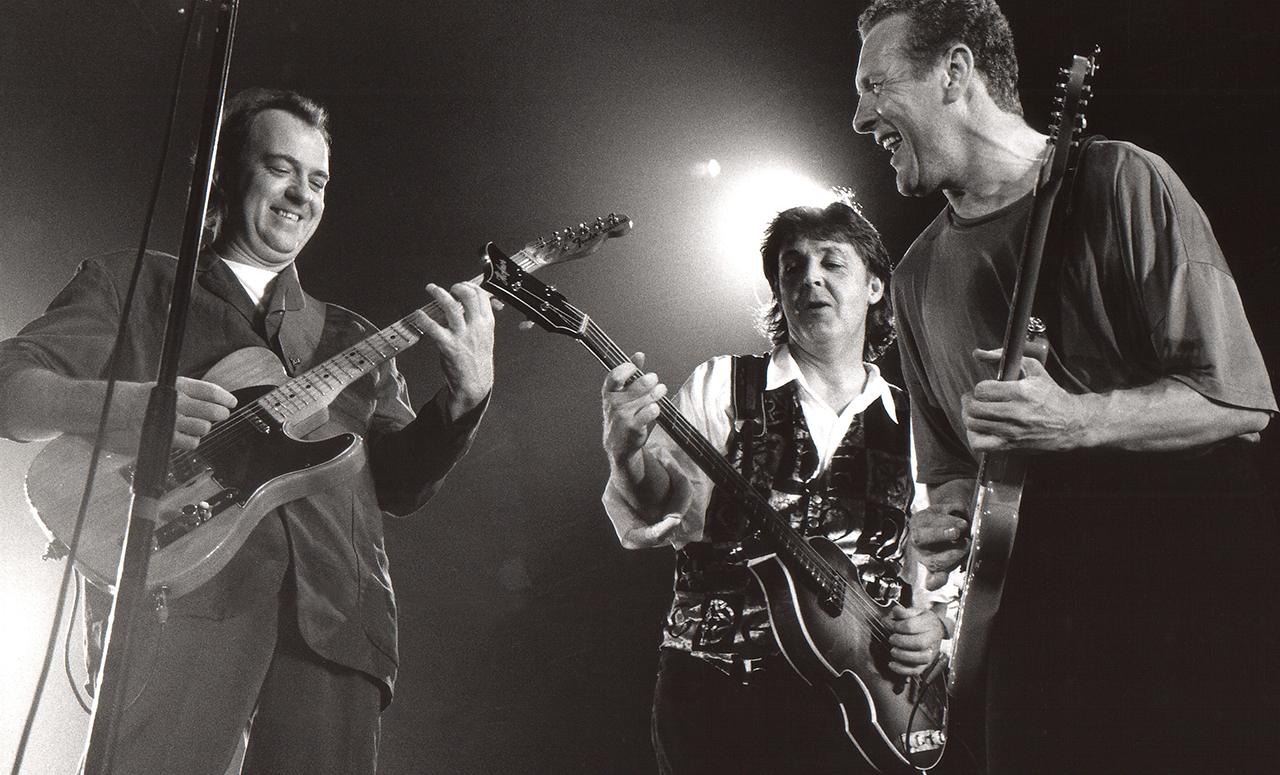“Chrissie Hynde and Linda McCartney were friendly. She said that Paul was looking for a guitar player”: Robbie McIntosh on a playing career running from the Pretenders to John Mayer – and the knock-off Japanese Strat he used on tour with a Beatle
In a lifetime of great gear and credits from Norah Jones to Celine Dion and Paul McCartney, the guitarist says he remains in love with his yellow Strat copy

Born in Surrey, England, in 1957, Robbie McIntosh grew up loving The Beatles, The Beach Boys and The Who, leading to the development of an uncanny melodic sense and a knack for knowing how to fill rhythmic space. For proof, dig into The Pretenders’ Learning to Crawl, Talk Talk’s It’s My Life and Paul McCartney’s Flowers in the Dirt.
He’s also lent his licks to more contemporary work including Tory Amos’ Scarlet’s Walk, Josh Groban’s Awake, Norah Jones’ Not Too Late and John Mayer’s Battle Studies.
His lack of widespread fame has led to a few inaccuracies appearing on his resume, like a credit on Aretha Franklin’s 1974 album With Everything I Feel in Me, which he did not play on. Then there’s the matter of Celine Dion’s 1997 record Let’s Talk About Love; he did play on the record, but he did not play on My Heart Will Go On.
Illness has slowed McIntosh down recently – but the 66-year-old maestro is still milling away at a slower pace. Asked to offer his best wisdom, he tells Guitar World: “Prepare to make compromises,” explaining:
“You’re being paid by someone else. If somebody doesn't like what you're doing, don’t do it. You have to listen a lot, be open, and not try to be too technical.
“The most important thing is: don’t get in the way of the vocals. That’s probably the best bit of advice. Listen to what the song’s about and where the voice is going – and never try to play over it.”
Before joining The Pretenders, you were friends with James Honeyman Scott. How did you first meet?
Get The Pick Newsletter
All the latest guitar news, interviews, lessons, reviews, deals and more, direct to your inbox!
“I met him in London when I think we had a mutual friend. I knew him just as ‘Jimmy’ before he became a part of The Pretenders. He was coming up in London and auditioning around the time, and we were certainly friends. We were both into Brit-rock like The Who and we loved The Beach Boys.”
Is it true that James reached out to you about joining The Pretenders before he died?
“Yeah. We have a very similar style, which was more tasteful than pyrotechnic, if you like. We’d stayed friends, and he had success with The Pretenders while I was working with a band at night. He got in touch with me around a year before he died and said he was thinking of augmenting the band, and he had me in mind.”
“Sadly he passed away in 1982. I think they had just come off tour and were about to start another album. And, of course, when he died, I didn’t really follow up – I was more upset than anything; and I didn’t know anybody else in the band.

“But eventually I got a call, so James must have mentioned my name to somebody in The Pretenders camp. I went along and did an audition and then Chrissie Hynde rang me up and asked me to join the band.”
Was it a challenge stepping in for James?
“He was a tough act to follow because they’d made great records; I was just kind of hanging in there, really. James added maybe more of a melodic landscape to some of Chrissie’s songs. She’s more into garage rock – Mitch Ryder, the Ramones and stuff like that – whereas James didn’t really get into punk rock.
“I don’t want to use the wrong word but I guess he added a bit more musicality to Chrissie’s songs. That was the secret with them – she provided the hard edge in her writing and James was a bit more melodic with his guitar background.”
What guitars did you bring with you to The Pretenders?
“I had two electric guitars: a Fender Telecaster – which was from the ‘70s and had a heavy-as-hell ash body – and a Gibson Les Paul Deluxe. I’ve still got both. I think I bought a Strat just because I needed something else. I was using my Marshall 20-watt amps. They were from the late 60s. I’ve still got those too.
“I had a shitload of acoustic guitars, but I can’t remember which ones. I had a classical guitar and a Gibson Hummingbird; and once we got into the studio I started using Chrissie’s Martin, which she eventually gave me. I’m looking at it right now.”
What was the first song you worked on?
“When we started Learning to Crawl, the first thing we did was 2000 Miles. It was September or October, and Chrissie had written this Christmas song and we’d rehearsed it, so we recorded it. After that, for the first bunch of sessions, we did Middle of the Road, I Hurt You and Watching the Clothes.”
Playing the Abbey Road medley was fantastic. And we did Sgt. Pepper. I’d grown up with The Beatles so I was familiar with their stuff
Why didn’t you play on Back on the Chain Gang?
“Billy Bremner played on that. That was right when Jimmy had died, and Chrissie had gone straight into the studio and did Back on the Chain Gang and My City Was Gone. I think Billy played on Thin Line Between Love and Hate, too – but Chrissie didn’t want Billy to be in the band.
“Billy is a great player and a good friend, but Chrissie felt that maybe he was a bit too rockabilly; he had played with Rockpile. I think she probably wanted somebody that was a bit more like Jimmy.”

Do you remember putting together Middle of the Road?
“Like most things, Chrissie would just play it with a straight-ahead strumming, kind of funky thing. I came up with the riff, and it went from there. That’s really how everything worked out. Another example is Don’t Get Me Wrong – she just shrugged, strummed those chords, and I came up with that kind of echoey backing thing.”
How did you end up working with Talk Talk on It’s My Life?
“I just did the acoustic guitar on that – there’s no electric. I think I used my Gibson Hummingbird or my Guild. I’d worked with the producer, Tim Friese-Greene, and he got me in there. I ended up doing three albums with them – It's My Life, The Colour of Spring and Spirit of Eden. I played electric on the last one; I would have used my Gibson ES-335.”
And how about Roger Daltry’s Under a Raging Moon?
“I had my Marshall 20-watt, which I used for pretty much everything. I also had a Fender Deluxe Reverb, and I always had the Telecaster and the Les Paul. But to tell you the truth, I have no idea how I started working with him – I just got recommended for it!”
How did you end up joining Paul McCartney’s band in 1988?
“I’d left the Pretenders in ’87, which was fine – me and Chrissie were still friends. I just had to get away from it a bit. She and Linda McCartney were friendly, and she said Paul was looking for a guitar player, and Chrissie said I’d left the band, so I was recommended.
“Paul was doing the Flowers in the Dirt album, and I went along and did some sessions. Then they asked if I’d be interested in joining the band. I said, ‘I would be if we don’t go away for ages!’ because I had a young family.
“They said, ‘No, we’re not going to be away for more than three or four weeks at a time. Paul doesn’t like to be away for ages either.’ So I said yes. We started recording Flowers in the Dirt in, I guess, ’89, and then we started the tour in the fall of ’89. After that, I stayed on for five years.”
I’m pretty good with my fingers on both hands because I played classical guitar for a long time
Did Paul have any preferences in terms of what gear you brought on the road?
“I needed something that covered our bases and was clean. I had a big Mesa Boogie rig, so I was able to get a pretty big sound. We started to do quite a lot of Beatles material, and I think I had my 335, and a yellow Strat, which I’ve still got. Bizarrely, on paper it’s a piece of crap but it’s one of my favorite guitars!
“It’s a ’72 Japanese reissue. I just changed the pickups. It’s got the big headstock and it’s nothing special, but it’s just great. I did own a ’57 Strat when I was with The Pretenders but I’d sold that by the time I was on tour with Paul. I wish I hadn’t – it's probably worth about $30,000 now!”

What were some of the most enjoyable songs to play with Paul?
“The Abbey Road medley was fantastic. And we did Sgt. Pepper. I’d grown up with The Beatles so I was familiar with their stuff. We did a lot of stuff from Flowers in the Dirt and Band on the Run. I’d suggest things like Fixing a Hole, and we did Let Me Roll It and All My Loving.”
Why did you leave?
“He just laid us off. He had to push on with The Beatles Anthology that they were doing, and he laid the band off at the beginning of ’94. We weren’t fired; he had to take a break and didn’t have a record. The anthology thing took up a lot of time for about a year or so.”
You started working with John Mayer around 2006. How did that happen?
“I didn’t know John at all. The only thing I knew about him was from working with Norah Jones the year before, and they’d both got popular around the same time. He certainly wasn’t that popular over here in the UK. But I got the gig through Steve Jordan and Pino Palladino. Pino is a close mate of mine; I was suggested by them.”
What did your touring rig consist of with John?
“I had an Epiphone Coronet. I haven’t got that anymore but I’ve got the Gibson SG Junior and a couple of Strats I used. And there were a couple of acoustics that I took, like my Martin D-21. One guitar I used a lot was a Duesenberg Double Cat. A lot of guys in Nashville started using them, and they got popular in America after I started with John. They’re great guitars.”
What was your approach to playing alongside John?
“I was just there to fill in the gaps. But there’s a couple of cool things I did – there’s a song called Say where John did the guitar part, and there’s a sort of string thing with two parts, and I worked that out. I’m quite proud of that.
“I remember him being quite impressed; I’m kind of good at sort of figuring things out, you know? And I’m pretty good with my fingers on both hands because I played classical guitar for a long time.”
I got to do a lot of stuff with John Mayer – promo stuff where it was just him and me with two guitars. It was great
Your work with John eventually tapered off after a few years. Would you work with him again?
“I don’t think he’d ask me back. I’m too old now. I think he’s moved on. I got to do a lot of stuff with him – promo stuff where it was just him and me with two guitars. There’s a great video of him and me on YouTube doing sets with no rehearsal. We’d do radio spots where we’d play two or three songs. It was great.”
You’ve kept on making solo records, with your last being Fortuneswell in 2021. What’s next?
“I don’t know – but not too much. I got really sick about three years ago with cancer. During the lockdown I had a thing called non-Hodgkin lymphoma and it was pretty advanced; it was stage four. I didn’t feel that sick but I’d lost weight and had a scan, and that's when they discovered my lymph nodes were all swollen up.

“I had to have chemotherapy, and thankfully that got rid of it. So I got slowed down a little bit, but I still do a fair bit of stuff for people because I can get very good results at home.
“I’ve got my own band and I’ll do gigs with them: it’s a little two-acoustic guitar band with a girl singer and three-part harmonies, which I love.”
So your days of touring the world are over?
“I’m not doing anything really major. But I am doing a concert in Cardiff in October, a tribute to David Crosby. I’ve got to bone up on some Crosby, Stills and Nash and Byrds stuff. I’m 66 now, so I’m what we call ‘retirement age’ over here – but I’m proud of all my albums and everything I’ve done.”
- Check out McIntosh’s solo work on Bandcamp.
Andrew Daly is an iced-coffee-addicted, oddball Telecaster-playing, alfredo pasta-loving journalist from Long Island, NY, who, in addition to being a contributing writer for Guitar World, scribes for Bass Player, Guitar Player, Guitarist, and MusicRadar. Andrew has interviewed favorites like Ace Frehley, Johnny Marr, Vito Bratta, Bruce Kulick, Joe Perry, Brad Whitford, Tom Morello, Rich Robinson, and Paul Stanley, while his all-time favorite (rhythm player), Keith Richards, continues to elude him.
“Even the thought that Clapton might have seen a few seconds of my video feels surreal. But I’m truly honored”: Eric Clapton names Japanese neo-soul guitarist as one to watch
“You better be ready to prove it’s something you can do”: Giacomo Turra got exposed – but real guitar virtuosos are being wrongly accused of fakery, too



![[from left] George Harrison with his Gretsch Country Gentleman, Norman Harris of Norman's Rare Guitars holds a gold-top Les Paul, John Fogerty with his legendary 1969 Rickenbacker](https://cdn.mos.cms.futurecdn.net/TuH3nuhn9etqjdn5sy4ntW.jpg)









